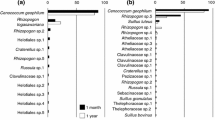Abstract.
The occurrence of suitable mycorrhizal inocula may be an important factor affecting the dynamics of plant communities. We investigated the persistence and diversity of ericoid mycorrhizal fungi in the soil of a mature Quercus ilex forest where ericaceous hosts were absent. Erica arborea was used as a bait plant and results were compared to soil samples from experimental plots where cuttings had allowed reappearance of this ericaceous species. Fungal endophytes were isolated and tested in mycorrhiza resynthesis trials. Sterile mycorrhizal endophytes were assigned to morphotypes whose consistency was confirmed by ITS-RFLP. The ITS region of a representative of each morphotype was sequenced. BLAST searches and Neighbour-Joining analysis indicated taxonomic affinities with different classes within Ascomycota. Our results indicate that ericoid mycorrhizal fungi persist and maintain mycorrhizal ability in habitats lacking the ericaceous host. Their persistence could favour the establishment of E. arborea seedlings in pure Q. ilex forests after disturbance phenomena.
Similar content being viewed by others
Author information
Authors and Affiliations
Additional information
Electronic Publication
Rights and permissions
About this article
Cite this article
Bergero, R., Girlanda, M., Bello, F. et al. Soil persistence and biodiversity of ericoid mycorrhizal fungi in the absence of the host plant in a Mediterranean ecosystem. Mycorrhiza 13, 69–75 (2003). https://doi.org/10.1007/s00572-002-0202-9
Received:
Accepted:
Issue Date:
DOI: https://doi.org/10.1007/s00572-002-0202-9




